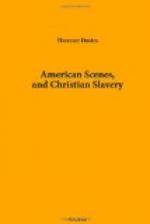The discourse was sound and good, but every word read. The disorderly conduct of the children in the gallery proved a great annoyance; and for all the solicitude of the ladies to get us away from the vicinity of coloured skins, not one of them had the politeness to offer us either Bible or hymn-book.
This visit of ours to the “Negro Pew” was immediately laid hold of by the Abolitionists, and made to go the whole round of their papers as a “testimony against caste.” This provoked into action the prolix pen of the celebrated Mr. Page, who wasted on the subject an immense quantity of ink and paper. “Page” after page did he pen; continued to do so, to my certain knowledge, for about three months after; and, for aught I know to the contrary, he may be paging away to this very day. This commotion answered my purpose exceedingly well,—my object being to bear testimony against the impiousness of such a distinction and separation in the house of God. It is, however, but justice to Dr. Patton to observe that the case is not singular, the peculiar celebrity of his “Negro Pew” arising entirely from the imbecile and somewhat profane apology volunteered by Mr. Page. In point of fact, Dr. Patton and his people, as I ascertained in conversation with him on the subject, are rather in advance of their neighbours in kind feeling towards the coloured people.
LETTER XXVII.
A Presbyterian Church in New York, and its Pastor—The Abbotts and their Institution—Union Theological Seminary—Dr. Skinner’s Church—New York University—A threatening “Necessity”—Prejudice against Colour--A Fact connected with Mr. ------’s Church--Another Fact in Pennsylvania—State of Public Opinion in New York—An Interview with Dr. Spring—A Missionary Meeting in Dr. Adams’s Church.
In the evening I preached by engagement for the Rev. ------, in the —— Presbyterian Church. It was pouring with rain, and not more than 150 persons were present. The pastor, who had visited me in a very fraternal manner, kindly proposed to devote part of the next day to showing me some of the “lions” of the city. The first place we visited was Mount Vernon, the institution of the Abbotts. It is a seminary for young ladies, with 200 pupils. The first of the brothers to whom we were introduced was John Abbott, the author of “The Mother at Home.” He is apparently 40 years of age. He introduced us to the room of the senior class, which consisted of 30 or 40 young ladies, from 14 to 25 years of age. They were engaged in a French exercise with Jacob Abbott, the author of “The Young Christian,” “The Corner Stone,” “The Way for a Child,” &c., &c. The exercise over, we were introduced to Mr. Jacob Abbott, and were requested to accompany him to a private sitting-room. I found him an exceedingly pleasant and unassuming man. He is 43 years of age, but looks younger. He wrote both “The Young Christian” and “The




